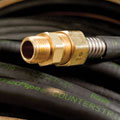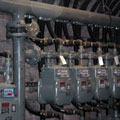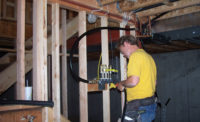Advancements in flexible-gas piping technology protect applications from lightning damage.

A recent report says that, on average, there are 22 million lightning strikes each year in the United States. That’s a number which at the same time seems completely plausible and unimaginable.
Commercial buildings - particularly those in the danger areas such as the Great Plains of the Midwest - are pawns in a risky game of Russian roulette. In 2009, more than 185,000 insurance claims due to lightning strikes resulted in nearly $800 million in losses. According to www.csstfacts.org, the amount of insurance claims is actually down from a five-year average of 226,000 claims, but those dramatic numbers show a need for more building protection.
Enter corrugated stainless-steel tubing products from OmegaFlex and Gastite. Both manufacturers have developed and enhanced systems over the last 10 years to help buildings find solace during threatening thunderstorms.
The first generation of CounterStrike from OmegaFlex was developed in 2003 and brought to market in the summer of 2004. After a couple years in the market, OmegaFlex recognized that some issues still arose, particularly with how the piping was laid and protected. In 2007, the company released a second-generation CounterStrike with fire resistance and improved resistance to electrical energy.
“We saw many cases where the yellow product wasn’t being bonded properly to the building’s electrical ground in accordance with our instructions,” says Steve Treichel, OmegaFlex senior vice president of corporate development and facilities management. “When nearby lightning strikes would energize the pipe and the pipe was near other metallic systems, there could be arcing between the two.”
The second-gen CounterStrike came to market in 2007 with a black, proprietary jacket and energy-dissipating properties designed to protect fuel gas systems and the stainless-steel pressure liner if the pipe became energized via a lightning bolt even if bonding is done.
“We made a commitment. Once this product was determined to be successful - meaning it would do everything we said it would do - it made sense to us that this should become our primary product line,” says Ed Moran, OmegaFlex vice president and national sales manager. “After September 2011, the CounterStrike product is the only CSST we supply to the marketplace.”
Contractors that use CounterStrike like it because OmegaFlex was able to make a product that overcame hurdles and saved time on installation. Also, since the second-gen CounterStrike doesn’t require a dedicated bonding jumper unless required by the local authority - but still can be, depending on the application requirement - a major potential problem is avoided. CounterStrike is in accordance with the National Electrical Code (NFPA 70), the National Fuel Gas Code (NFPA 54) and the International Fuel Gas Code.
“In some cases, the second-generation product can be installed without having to use the additional bonding that is required for the yellow CSST,” Moran says. “Without that additional bonding requirement, significant savings are realized in time and materials.”
Since its debut eight years ago, CounterStrike has no reports of lightning-related damage. “That is a pretty long history to prove the effectiveness of the product,” Moran says.

FlashShield from Gastite
Six years ago, Gastite upgraded its FlashShield CSST piping, which originally featured a yellow jacket. Now it has an expanded aluminum metal foil with two layers of formulated polymer jackets. FlashShield also has a unique fitting design to make a conductive shield, which diffuses heat and electrical energy.
FlashShield is up-to-date on the National Fuel Gas Code and the manufacturer made sure the product was at its best against damage.
“This significantly reduced the likelihood of any damage due to potential arcing between two metallic systems because of lightning,” states Craig Barry, Gastite’s vice president of marketing. “The specialty mesh was chosen after research revealed aluminum is the material of choice for lightning strike protection in commercial aircraft.”
Contractors using FlashShield aren’t bound by singular design requirements regarding bonding and codes, but if there is a question the stricter code protocol will be followed. “We do not require FlashShield to be bonded and grounded in our design and installation instructions,” Barry explains. “However, in the event there is a conflict between this design and installation guidelines and local codes, the more stringent requirement will take precedence.”
Training is key
OmegaFlex requires thorough training before CounterStrike can be installed at jobsites. The company holds the majority of its training sessions in the field; Moran states nearly 150,000 installers have been trained since CounterStrike hit the market in 2004.
“It’s part of our standard that all installers be properly trained,” Moran says. “Training is a big part of how we go to market. We have regional sales managers or manufacturers reps that will conduct training. It’s in-depth and it’s something we take seriously.”
Treichel adds: “The training supplies each installer with a design installation guide and complete instructions. (Installers) take a test at the end of the training session. They receive a training card showing they took the program and they’re also kept in a database of trained installers at OmegaFlex. The database is updated as new people get trained.”
OmegaFlex features an expanded training focus. “We also provide training to code officials, home building inspectors and any other official who would like to be trained. We’ve trained many officials in gas companies,” Treichel says. “It’s not just the installer that we focus our training on, it’s across the board with all officials. It’s anyone we can get to.”
Gastite continues training on both its first-generation yellow jacket product as well as FlashShield.
“We train on a daily basis across the United States and Canada,” Barry says. “We want to make sure that any contractor purchasing and installing our products understands the entire system installation methods.”
Strong sales and results
Both Gastite and OmegaFlex say they are seeing an increase in sales for their CSST piping. Gastite is seeing FlashShield being a major player in those areas of increased lightning activity regions.
“The demand for FlashShield, especially in high lightning areas, is growing,” Barry says. “We’re glad to see the acceptance and use in those areas.”
Moran says CounterStrike’s sales have “grown significantly” in both the commercial and residential markets. Most importantly, there haven’t been any issues in the field.
“It’s really hard to measure how well a product is working other than over a long period of time,” Moran says. “This market is a little more conscientious than people would tend to believe. It’s not all about price. It’s about putting the best product in.”

